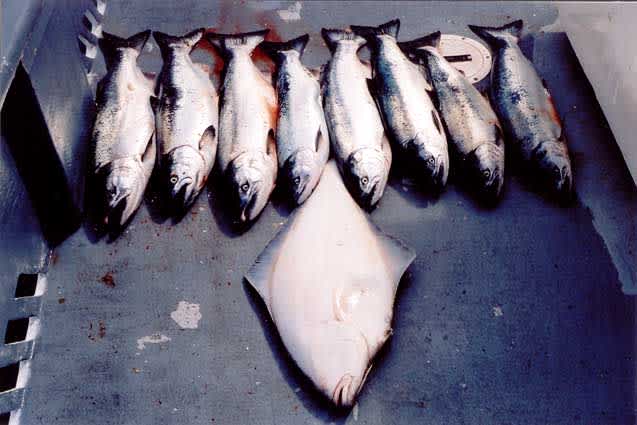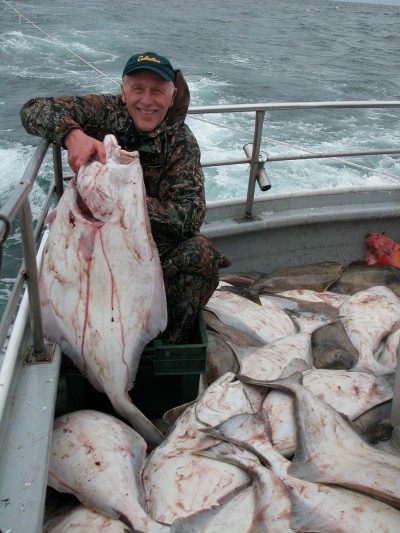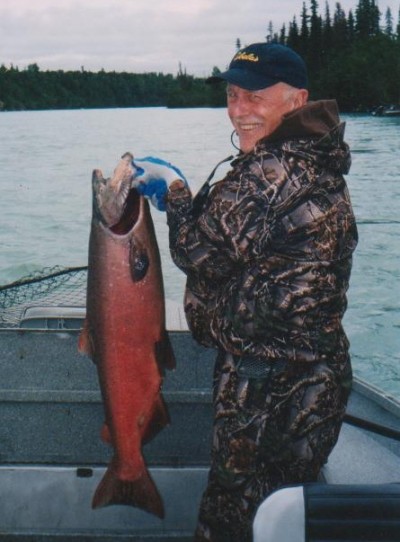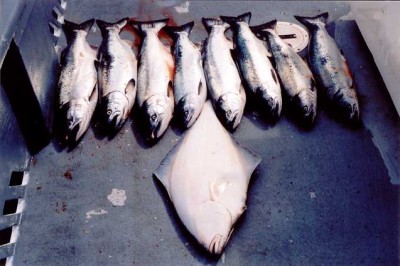Fishing Guides: The Good, the Bad, and the Ugly
James Swan 05.15.13

If you’re planning a summer fishing trip to Alaska, or elsewhere for that matter, now is the time to be checking out guides and making reservations.
I learned some valuable lessons about guides a couple years ago when I spent a week fishing on the Kenai Peninsula in Alaska with a writers excursion trip sponsored by the U.S. Sportsmen’s Alliance, which deserves credit for leadership excellence in protecting sportsmen’s rights. Hey, someone has to do the hard stuff!
Aside from testing out the latest gear furnished by Cabela’s, as things turned out we ended up conducting a study of fishing guides; one of the most crucial, and often overlooked, elements in determining the success or failure of a fishing trip. I won’t name the ones that I will criticize, because hopefully they have changed. But you will get the drift of what I’m saying.

Halibut out of Homer
We began with a halibut charter out of Homer with a guy who was supposed to really know where the big ones were. We started with a two-and-a-half hour ride to a special spot 44 miles out where the milky glacial runoff waters of Cook Inlet intersect with the crystal clear Bering Sea. There were two mates and a captain for 15 anglers. En route, one mate explained what we were to do. When we finally anchored in 200-foot-plus deep water with rolling eight-foot swells, the action was immediately hot and heavy for fish. My two-pound sinker had barely hit bottom when a 30-pound halibut slammed it.
Soon just about everyone had a big halibut on, or was puking over the side. Sometimes both. Other boats in sight seemed to be closer to shore, in the shelter of an island, but we were sure in thick of the fish.
It was chaotic, even dangerous at times with the rolling water, slippery decks, and big fish, but in two hours everyone had nearly limited out with two halibut a piece up to 45 pounds. Then the captain announced he was changing locations. When we got to the new location, we found a second boat from the same charter, floundering without power due to a cracked engine block.
In rolling seas, our captain connected to the other boat with a 100-foot towline. Then he backed off, tossed in an anchor, and anglers from both boats were told to keep fishing.
In this new area we started catching eight- to 10-pound cod. We were told they were not good to eat. When they were thrown back, their swim bladders were ruptured, so they died and floated away. They did not go to waste, as the cod were making a meal for seals and sea gulls, but I don’t agree with this policy at all, unless the fish are filled with parasites, or something like that. You kill it, you keep it on my boat. And those cod, it turns out, actually are great eating and good for you. Walk into Trader Joe’s and try some.
People on our boat limited out on halibut, but the jerking tow rope added to already rough conditions, so even though the other boat had only about a fish per person, they decided to head in, with our boat towing the disabled boat.
On the ride in, the towrope broke five times. Yes, five times. Once the towline got caught around one of the twin screws from our boat, disabling one of our engines. Finally, on one good engine out of four for the two boats, we arrived back at the dock four-and-a-half hours later.
At the dock, there were near fistfights between captain and crew on the disabled boat and their party, who were demanding a refund. To add insult to injury, a mate gave away one of our big halibut to people on the totally disabled boat to try to appease them–without asking us.
The captain knew where the fish were, but he seemed oblivious to the quality of service provided for his clients. Seems to me the Coast Guard should have been called to help the disabled boat. The halibut should not have been given away without our permission. The mates also took some monster red snappers we caught for their share of the catch, again without asking.
Our party quickly decided to cancel our next day’s charter on the same boat. At first, the charter company demanded we pay for the charter because we had signed a contract. Later, they backed down when it became clear both boats were unable to fish without major repairs.

Kings on the Kenai
Contrast this fiasco with a half-day charter for kings on the Kenai River with guide number two. After a hearty handshake greeting, guide number two takes out a pen and writes down everyone’s name so he can remember them.
On the water, guide two seems to really know the river, but he is constantly checking in with others on a cell phone about where the fish are running. I caught and released a small (by Kenai standards) 15-pound king, and then nailed a big, feisty, hook-jawed male king 30-pounder that went in the box. I know, they get up to 97 pounds up here, but I was happy as a clam. Limit is one per day. Time to watch eagles.
In between fish, guide two fills us in on the salmon fishery, the local politics of fishing, the Stellar’s Sea Eagle that had been around the week before, and so on, so we could write stories about the place. And then, suddenly a moose decided to swim across the river just upstream. As it waded into the river and began to swim, the current swept it downstream and it nearly collided with our boat. The guide skillfully let us get close enough to the swimming moose for pictures, but did not harm the moose or us.
We told him about the halibut charter. He shook his head and said, “Courtesy should be the bottom line for a guide.” Amen.
Kings and more kings
Now onto guide number three, again for kings on the Kenai. He was a former minister, and he also quickly memorized all our names and engaged in conversation with each person in the boat. He worked hard to find fish, asked us frequently if we needed anything–he was there to serve us. He treated us with professionalism and courtesy. At the end of the day our party of eight had boated four kings up to 47 pounds.
We spent the next day fishing Kenai River sockeyes from the bank in Soldotna. The sockeye is God’s gift to the fisherman. A million reds move through here. Six-a-day was the limit and we limited out without keeping foul-hooked fish. They run along the banks so anyone can catch them, and man are they good eating. No need for guide here. Nailed a couple Dolly Vardens and rainbow to boot. All these fish were quick frozen at a plant in Soldotna.
Finally, on to Seward to fish for silvers among the spectacular fjords and glaciers.

Sushi and silvers from Seward
As we were leaving the dock in Seward, guide number four lets a mate take over the wheel, calls everyone into the cabin, introduces himself and gives us a 10-minute orientation to the day’s fishing. He describes the water and weather, as well as what to expect and makes a point to say that he is there to serve us. He also talks about his ethics about conservation. Each member of the crew has their name on their shirt and introduces themselves politely. Immediately we strike a positive bond that is to last all day long.
When we began fishing, the captain and two very skilled and polite mates were there to help bait hooks, land fish, and answer any questions. The captain periodically checks on how people are feeling and tries to keep the boat over the fish and out of the largest swell. In three hours outside the bay, we had our limits of three silvers each up to eight pounds and several large black rockfish. And no one got seasick.
The law says you can catch three more silvers in Resurrection Bay, so we headed back into the Bay, where yours truly bagged a nice halibut to win the largest fish of the day pot. The salmon fishing was slower, so the captain asked if he could have a salmon. He proceeded to make fresh salmon sushi, with soy sauce and wasabi, and a second course of delicious seviche. This has to be the tastiest meal aboard a boat I have ever had.
On the way in, we had 20 minutes to spare, so he took us to a special place where we could watch and photograph a pair of nesting eagles, and catch some unusual rockfish. A day in a gorgeous setting like Seward, with such a courteous, professional and hospitable captain and crew, was heaven on earth.
Alaska is a sportsmen’s paradise, but depending on the guide you have, it can be heaven or hell.
A guide and/or charter captain needs to keep people safe, and obey the laws. They should know the water and know how to find fish and what’s the best way to catch them. But they also need to realize that they are providing a service to their clients. Hospitality, courtesy, ethics, and camaraderie are damn important to a successful trip, over and above fishing.
There are schools to train guides, but such training is not required. I believe it should be mandatory.
Check for references if you don’t know what guides to choose. So, what guides do I recommend on the Kenai Peninsula?
- For king salmon and halibut around Soldotna (oh, I wish we had fished halibut with him) contact Key-O’s Guide Service. They know every fish and fisherman on the Kenai by their first name.
- My other two thumbs way up goes to Ninilchik Charters, which charters on both fresh and saltwater throughout the Kenai.
- And, I promise you that you will never forget the beer batter halibut from the Seward Brewing Company in Seward.
Hope your fishing trip is a good one. Pleasant memories of the past can become dreams for the future.

